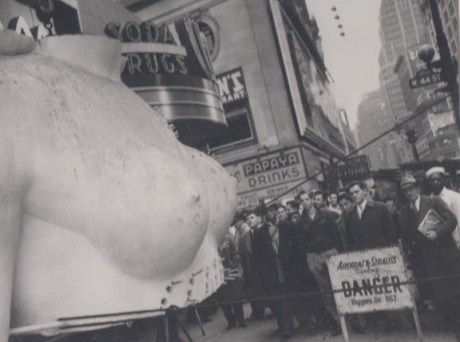 The 102nd meeting of the NY Comics & Picture-story Symposium will be held on Tuesday, October 7, 2014 at 8 pm at Parsons The New School, 2 West 13th Street, in the Bark Room (off the lobby). Free and open to the public. Please note 8 pm starting time.
The 102nd meeting of the NY Comics & Picture-story Symposium will be held on Tuesday, October 7, 2014 at 8 pm at Parsons The New School, 2 West 13th Street, in the Bark Room (off the lobby). Free and open to the public. Please note 8 pm starting time.
Presentation: Jay A. Gertzman: Look, Look, Just Look: Scopophilia and the 20th century Illustrated Book.
My talk will be about the way 20th century drawings illustrate texts by substituting the mutual sexual contact and its fulfillment—which is the subject of the narrative—with images which stimulate auto erotic responses in the viewer. Freud’s phrase for this is scopophilia, the substitution of the eye for the penis. What results is prurience and the substitution of shame for pleasure in establishing a loving relationship.
After a few book illustrations exemplary of gazing and fantasizing, I will show three types of graphic illustrations. The first are drawings prepared for wealthy consumers: erotic bookplates, extra-illustrated images in finely printed editions of classic pornography, and a deluxe privately printed 1930s edition of Lady Chatterley’s Lover.
The next class of drawings was used to sell prurient but not explicit materials that could be used to interest, but not shock, middle- and working-class consumers with conventional sexual tolerances, given the moral consensus of their communities. Illustrations for mail order fiction, non-fiction, and correspondence clubs, as well as pulp magazines and paperback novels, are rich sources for judging what these purveyors of borderline material wanted to tease their customers with. Many of these also show men looking at females—the keyhole motif was famous for its frequent appearance in advertisements as well as books themselves.
A final set of slides would illustrate materials sold to, or created by, underclass and outcast people. These are for the most part explicit (regarding various sexual acts and full nudity) and at the same time more expressive of unruly desires than they are prurient teases: playing cards, tattoos, Tijuana Bibles (“little dirty comics”), sketches on boarded-up windows of Times Square bookstores and peep palaces, graffiti, and covers and interior drawings for hard core paperbacks.
In all three categories, there are drawings which subvert the concept of prurience and the identification of sex with furtive masturbatory pleasure.
Jay A Gertzman retired in 2000 as a professor of English at Mansfield U. He taught a diverse set of courses: radical themes in modern literature, noir crime fiction, D H Lawrence, Shakespeare, literary censorship, in addition to composition at the freshman and upper class levels.
His research specialty is publishing history. He has published four books on this subject.
In Bookleggers and Smuthounds: The Distribution and Prosecution of Erotica, 1920-1940 (U of Pennsylvania Press, 1999), he discussed publishers, distributors and dealers and their symbiotic relationship with private “decency” groups and police. The book details the methods of underground publishing and the way booksellers got sexually explicit texts into readers’ hands. His Samuel Roth, Infamous Modernist, was published in the spring of 2014 by the U. Press of Florida. It is a biography of the man who served two federal prison terms for distributing erotica through underground sources and the U.S. mails. After publishing parts of Ulysses in 1926 without explicit permission from James Joyce, he was denounced as a “thief” and “pirate,” although there was no international copyright agreement at the time. Roth’s long career as editor, poet, and iconoclast culminated in Roth v. U.S. (1957), a major event in First amendment liberalization.
